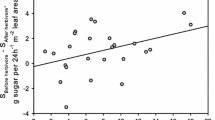Abstract
Following perception of herbivory or infection, plants exhibit a wide range of inducible responses. In this study, we found ultraweak photon emissions from maize leaves damaged by Helicoverpa armigera (Noctuidae). Interestingly, mechanically damaged maize leaves treated with caterpillar regurgitants emitted the same intensity and pattern of photon emissions as those from maize leaves damaged by caterpillars. Furthermore, two-dimensional imaging of the leaf section treated with the oral secretions clearly shows that photon emissions were observed specifically at the lip of the wound exposed to the secretions. These results suggest that the direct interaction between maize leaf cells and chemicals contained in caterpillar regurgitants triggers these photon emissions.



Similar content being viewed by others
References
Abeles FR (1986) Plant chemiluminescence. Annu Rev Plant Physiol 37:49–72
Alborn HT, Turlings TCJ, Jones TH, Stenhagen G, Loughrin JH, Tumlinson JH (1997) An elicitor of plant volatiles from beet armyworm regurgitant. Science 276:945–949
Eichenseer H, Mathews MC, Jian LB, Murphy JB, Felton GW (1999) Salivary glucose oxidase: multifunctional roles for Helicoverpa zea? Arch Insect Biochem Physiol 42:99–109
Enkerli J, Felix G, Boller T (1999) The enzymatic activity of fungal xylanase is not necessary for its elicitor activity. Plant Physiol 121:391–398
Felton GW, Bi JL, Summers CB, Mueller AJ, Duffey SS (1994) Potential role of lipoxygenases in defense against insect herbivory. J Chem Ecol 20:651–666
Halitschke R, Schittko U, Pohnert G, Boland W, Baldwin IT (2001) Molecular interactions between the specialist herbivore Manduca sexta (Lepidoptera: Sphingidae) and its natural host Nicotiana attenuata. III. Fatty acid-amino acid conjugates in herbivore oral secretions are necessary and sufficient for herbivore-specific plant responses. Plant Physiol 125:711–717
Iyozumi H, Kato K, Makino T (2002) Spectral shift of ultraweak photon emission from sweet potato during a defense response. Photochem Photobiol 75:322–325
Kawabata R, Uefune M, Miike T, Okabe H, Takabayashi J, Takagi M, Kai S (2004) Biophoton emission from kidney bean leaf infested with Tetranychus kanzawai Kishida. Jpn J Appl Phys 43:5646–5651
Korth KL, Dixon RA (1997) Evidence for chewing insect-specific molecular events distinct from a general wound response in leaves. Plant Physiol 115:1299–1305
Makino T, Kato K, Iyozumi H, Honzawa H, Tachiiri Y, Hiramatsu M (1996) Ultraweak luminescence generated by sweet potato and Fusarium oxysporum interactions associated with a defense response. Photochem Photobiol 64:953–956
Mattiacci L, Dicke M, Posthumus MA (1995) β-Glucosidase: an elicitor of herbivore-induced plant odor that attracts host-searching parasitic wasps. Proc Natl Acad Sci U S A 92:2035–2040
Musser RO, Hum-Musser SM, Eichenseer H, Peiffer M, Ervin G, Murphy JB, Felton GW (2002) Herbivory: caterpillar saliva beats plant defences. Nature 416:599–600
Ohya T, Kurashige H, Okabe H, Kai S (2000) Early detection of salt stress damage by biophotons in red bean seedling. Jpn J Appl Phys 39:3696–3700
Ohya T, Yoshida S, Kawabata R, Okabe H, Kai S (2002) Biophoton emission due to drought injury in red beans: possibility of early detection of drought injury. Jpn J Appl Phys 41:4766–4771
Roschger P, Devaraj B, Scott RQ, Inaba H (1992) Induction of a transient enhancement of low level chemiluminescence in intact leaves by anaerobic treatment. Photochem Photobiol 56:281–284
Slawinska D, Slawinski J (1983) Biological chemiluminescence. Photochem Photobiol 37:709–715
Stout MJ, Workman KV, Bostock RM, Duffy SS (1998) Specificity of induced resistance in the tomato, Lycopersicon esculentum. Oecologia 113:74–81
Truitt CL, Pare PW (2004) In situ translocation of volicitin by beet armyworm larvae to maize and systemic immobility of the herbivore elicitor in planta. Planta 218:999–1007
Truitt CL, Wei HX, Pare PW (2004) A plasma membrane protein from Zea Mays binds with the herbivore elicitor volicitin. Plant Cell 16:523–532
Voelckel C, Baldwin I (2004) Generalist and specialist lepidopteran larvae elicit different transcriptional responses in Nicotiana attenuata, which correlate with larval FAC profiles. Ecol Lett 7:770–775
Walling LL (2000) The myriad plant responses to herbivores. J Plant Growth Regul 19:195–216
Acknowledgements
This study was partly supported by a Grant-in-Aid for Scientific Research (no. 15580090) and the 21st century COE program for Innovative Food and Environmental Studies Pioneered by Entomomimetic Sciences from the Ministry of Education, Culture, Sports, Science and Technology of Japan. Naoko Yoshinaga is the recipient of a research fellow (no. 01212) from Japanese Society for the Promotion of Science for Young Scientists.
Author information
Authors and Affiliations
Corresponding author
Rights and permissions
About this article
Cite this article
Yoshinaga, N., Kato, K., Kageyama, C. et al. Ultraweak photon emission from herbivory-injured maize plants. Naturwissenschaften 93, 38–41 (2006). https://doi.org/10.1007/s00114-005-0059-9
Received:
Accepted:
Published:
Issue Date:
DOI: https://doi.org/10.1007/s00114-005-0059-9




